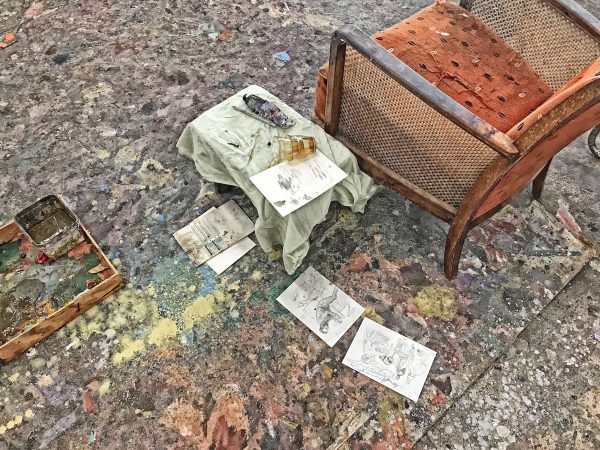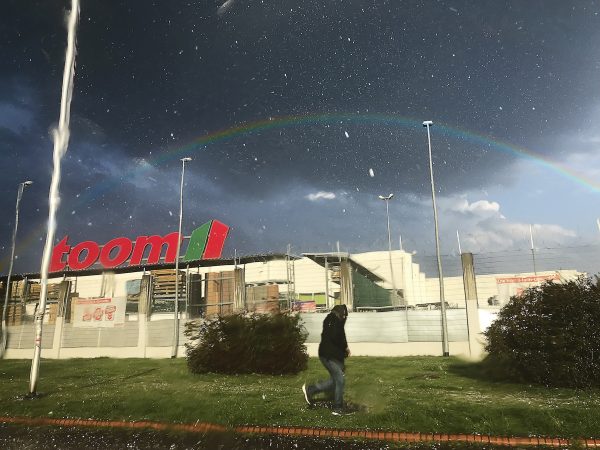Neo Rauch: Aus dem Boden / From the Floor will be on view at The Drawing Center until July 28. More information about the exhibition is available here.

Excerpts from “Interview” with Neo Rauch by Ena Swansea
ENA SWANSEA: Do you think that some of the questions that you have been privately, wordlessly, exploring for all this time have never been pointed out by the many people who have written about your work?
NEO RAUCH: I am mainly concerned with an image’s power of seduction which should vault over the beholder, capture him completely… to debauch him out of the directness of his daily conventions, to derail him right-angled into the sphere of the indescribable. Painting, after all, is the medium responsible for those things for which we lack words or terms. Meaning is the cage within which the tiger stripes pace up and down.
ES: For a viewer seeking subject matter, your work is mesmerizingly unclear. When it first appeared, it was immediately seized upon as an almost magical historical necessity. Were you thinking of the past all that much? Nostalgia, the trancelike response to the tyranny of a faceless controlling state? Did you feel that these interpretations, responding to the G.D.R. and “the workers,” were corny? What misinterpretations bothered you?
NR: My process is far less a reflection than it is drawing from the sediments of my past, which occurs in an almost trance-like state. It is no reflection—there’s no sparkling blade of an analytical scalpel driving into the mass of memories. It’s more a semiconscious gathering of particles that gets stirred up and washed ashore by the anchor that is pulled by my barge. And there is also no selection according to hierarchical criteria, during the sightings of catch and release— to stick with this maritime picture. The selection exclusively follows aspects of formal aesthetic usability. Perhaps there is a lot of G.D.R. within my work as seen through the eyes of some beholders, which results from the process you described. However it is anything but a deliberate analytic procedure.
ES: In your creative firmament there is an undergrowth of humor inside there figures who seem very purposeful, but often they seem to have no fear, nor any mood nor attitude about the endless tasks you have assigned them. Perhaps they are only projecting placidity when faced with something unspeakable?
NR: Well, I’m trying to induce a moment of inner premeditation to my creatures, which can lead to an action at any time. But it is only the seed of an action, or of an excess, that can be drawn from them. They can be experienced as being in a state of somnambulistic intuition. And it is up to the spectator to mentally continue, to execute the situation that I am offering.
ES: How do you create a person in a painting?
NR: You and I have talked before about the creation of physiognomy. Only when I reach the feeling that I could coexist together with the creature, in the best unanimity, which having different and critical distances but eventually still affirmative, can I then stop working on it. But only as long as I haven’t got the feeling, “No, if he came into the room right now, I wouldn’t approve of it.” It is still about implying the possibility that by means of a one-time coin injection— in the form of attention and sensual sagacity by the viewer— a perpetuum mobile could be triggered.

ES: Might there be a combination of sources helping to nourish you image-power? If so, would it be related to the duplicitous atmosphere of Eastern Germany when you were young, where social behavior could not always be straightforward? And that, perhaps, combined with the love, care, hidden fear, and hope of your mother’s parents as they raised you?
NR: These are questions that would touch on the content, which in turn touch on motivation. I believe that if I started to think about that, I would rain on my own parade. If I knew where it came from, if I pointed the focal-ray of my interest on the source-area of my inspiration, I would drain it. I’m only in conversation with myself, with my subconscious.
The full text of Ena Swansea’s Interview with Neo Rauch can be read in the exhibition catalog, available here.
